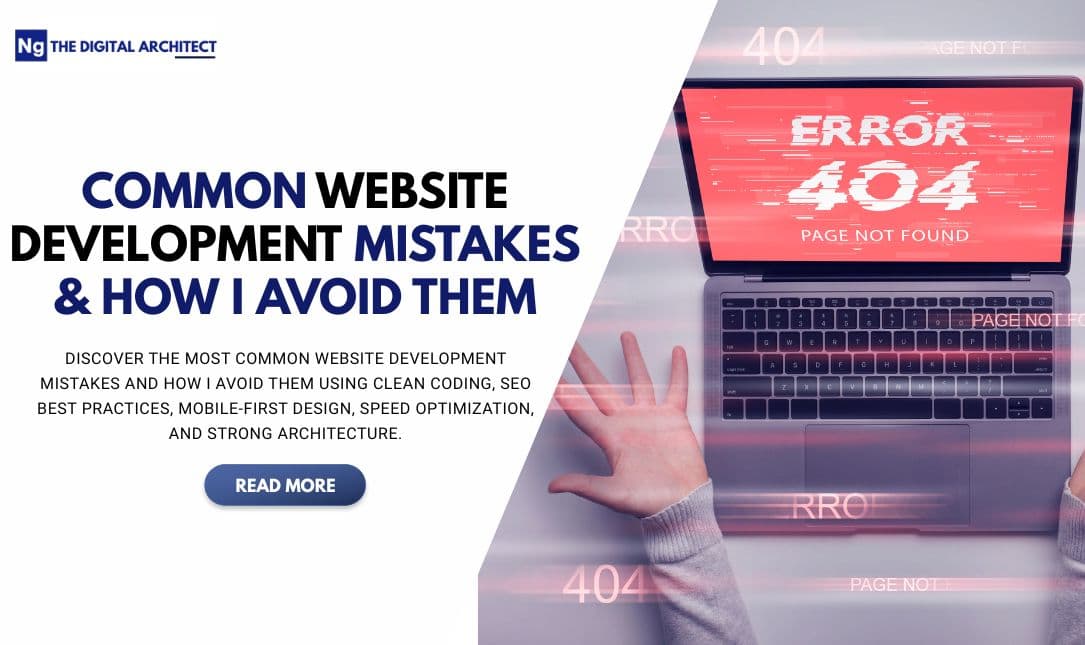Building a website may look simple on the surface, but professional website development requires precision, planning, and a strong technical foundation. Many websites fail not because of poor content or weak marketing—but because of critical development mistakes that affect speed, SEO, user experience, security, and scalability.
I am Nishant Gupta – The Digital Architect, and with years of experience in custom website development, I’ve observed hundreds of common mistakes developers make. In this blog, I’ll explain the top website development mistakes and how I completely avoid them to build high-quality, fast, and scalable websites.
1. Ignoring Mobile-First Development
More than 70% of users browse on mobile devices, yet many developers still design websites for desktop first. This results in broken layouts, unreadable content, and poor mobile UX.
How I avoid this mistake:
- I design mobile-first UI/UX layouts
- I test on real devices, not just Chrome tools
- I use responsive grids, optimized spacing, and flexible units
- I ensure every element works perfectly on all screen sizes
A website should feel natural and smooth on mobile—not squeezed or zoomed.
2. Using Heavy or Unoptimized Code
One of the biggest mistakes developers make is writing:
- Heavy JavaScript
- Unused CSS
- Nested blocks
- Unnecessary animations
- Multiple external libraries
This slows the website dramatically.
How I avoid this mistake:
- I write clean, minimal, and optimized code
- I choose lightweight frameworks like Tailwind CSS
- I avoid unnecessary plugins
- I optimize JS for performance
A fast website always wins—both for SEO and user experience.
3. Poor Database Structure & Query Overload
Many websites slow down because of:
- Inefficient database design
- Repeating queries
- No indexing
- N+1 query problems
This impacts speed, scalability, and user experience.
How I avoid this mistake:
- I plan database architecture before building features
- I optimize all queries
- I use indexing for fast filtering
- I use eager loading to reduce query count
This keeps websites fast—even with thousands of records.
4. Not Optimizing Website Speed
Speed is one of the most ignored factors in website development. Slow websites lower conversions and ranking.
How I avoid this mistake:
- Image compression (WebP)
- Caching strategies
- Lazy loading
- Minifying JS/CSS
- Using CDN for assets
Every website I build loads quickly, improving SEO and user satisfaction.
5. Weak or Missing SEO Structure
Many developers build beautiful websites—but without SEO structure. Common SEO mistakes include:
- No meta tags
- Poor heading structure
- Missing schema
- Unoptimized URLs
- No alt tags
How I avoid this mistake:
- I follow correct H1, H2, H3 hierarchy
- I create clean and SEO-friendly URLs
- I add schema markup (Local, Article, Breadcrumb)
- I set dynamic meta tags for each page
An SEO-ready structure gives your website a strong ranking foundation.
6. Ignoring Security Best Practices
Security is often forgotten or ignored during development. Developers sometimes leave:
- Vulnerable inputs
- Open endpoints
- Weak authentication
- No validation rules
How I avoid this mistake:
- I secure all inputs with sanitization
- I use Laravel’s built-in CSRF, XSS, and SQL protection
- I validate every user request
- I implement secure authentication & roles
Security is built into my workflow—not added later.
7. Using Page Builders for Complex Websites
Page builders are easy but not suitable for:
- Speed
- Custom functionalities
- SEO
- Large-scale systems
They generate heavy code and slow down websites.
How I avoid this mistake:
- I build custom websites using Laravel
- I control every line of code
- I create clean UI/UX without drag-and-drop limitations
This ensures long-term stability and high performance.
8. Not Using a Proper UI/UX Structure
A big mistake is designing websites without considering:
- User journey
- Reading patterns
- CTA placement
- Visual hierarchy
How I avoid this mistake:
- I design UI/UX based on user behavior
- I place CTAs strategically
- I focus on simplicity and clarity
- I use spacing and alignment for smooth readability
A website should guide users—not confuse them.
9. Not Testing Properly Before Launch
Many websites launch without checking:
- Forms
- Responsiveness
- Speed scores
- Broken links
- SEO readiness
- Admin panel functionality
How I avoid this mistake:
- I run full website testing before launch
- I check mobile + desktop views
- I test all forms manually
- I verify speed and optimize if needed
The website goes live only after it passes my complete quality checklist.
10. No Scalability Planning
A common mistake is building a website only for the present—not the future. When the business grows, the website fails.
How I avoid this mistake:
- I use scalable architecture
- I keep code modular
- I plan for future features
- I separate logic, views, and controllers properly
This allows the website to grow with the business—without rebuilding everything.
Why Avoiding These Mistakes Matters
- Better search rankings
- Higher conversions
- Long-term stability
- Less maintenance cost
- Better user satisfaction
A well-built website creates a strong online presence and helps businesses grow faster.
Final Thoughts
Website development is much more than coding—it requires strategy, planning, optimization, and a deep understanding of user behavior. By avoiding common development mistakes, I deliver websites that are fast, secure, scalable, and ready to perform from day one.
If you want a well-structured, high-quality, mistake-proof website, I can help you build it from scratch—professionally and efficiently.
Contact me today to discuss your website development needs.






